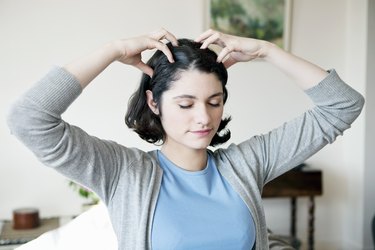
If you've noticed that your hair seems to be thinning and breaking, it's easy to panic and start trying every potion, product and procedure out there. Take a deep breath.
Your first step is to visit your doctor to discuss possible causes (there are quite a few) and treatment options. But in the meantime, there is a simple, at-home tactic that's worth a try: scalp massage, sometimes called scalp exercise.
What Are Scalp Exercises?
Scalp massage involves "running, kneading or applying pressure to the skin of the scalp with the fingers and hands," explains the Pacific College of Oriental Medicine. It's not illogical to suppose that massage can alleviate hair loss. Daily scalp massage can increase blood flow to the scalp, and thus to the hair follicles, which are the only living part of the hair.
There's evidence, albeit limited, to back up the idea.
Among 327 women and men with androgenetic alopecia (a common type of hair loss) who tried scalp massage for 11 to 20 minutes a day, more than two-thirds self-reported that their hair loss leveled off or that they experienced hair regrowth. The findings were reported in the March 2019 issue of Dermatology and Therapy.
However, the retrospective study, which followed people who had accessed literature and watched a video demonstration of a twice-daily scalp massage protocol, had a number of limitations and lacked the rigor of a randomized controlled trial.
Bottom line: It may help, and certainly can't hurt. At the very least, daily scalp massage can be a great stress-buster at the end of a long day. And stress is known to be a contributing factor to hair loss, according to the Mayo Clinic. In fact, a small study of 34 women published October 2016 in the Journal of Physical Therapy Science found that bi-weekly scalp massage lowered their stress hormone levels as well as blood pressure.
Plus, "Massaging the scalp can help with soothing symptoms such as itching, tightness of the scalp and alleviating minor pain or soreness of the scalp caused by inflammation," New York City-based trichologist Sophia Emmanuel tells LIVESTRONG.com. "When hair follicles are inflamed for long periods of time, it can cause hair loss."
Here are a few scalp exercises to get you started on your quest for healthier-looking hair.
Circular Head Massage
Emmanuel recommends this simple massage before washing your hair. Start at the nape of your neck and work your way up, using a gentle circular motion. Work small portions of your scalp at a time. Use clockwise motions for the first three minutes, then reverse direction, using counterclockwise circular motions for the next two minutes. Be certain to massage your entire scalp area up to the hair line. Just be careful that you're using your fingertips, not your fingernails, cautions Emmanuel.
"It can help with exfoliating prior to shampooing, alleviating dry, itchy scalp, especially when using products that leave a refreshing feeling," she says. "Ingredients like peppermint, rosemary, lavender or geranium can all help the scalp feel cool and make you feel relaxed as well."
Read more: 9 Things to Do for Amazing Hair
Laxity Exercises
For those who opt for a hair transplant as treatment for hair loss, scalp "laxity exercises" are often recommended, according to Bernstein Medical Center for Hair Restoration.
Sit upright in a firm chair. With palms open, place your hands onto the back of your scalp. Clasp your fingers together, but don't let your thumbs touch. Slowly start moving your scalp up and down without moving your fingers, and repeat 20 times. Remove your hands and relax for 10 seconds. Continue the exercise for a total of 15 minutes, and perform daily.
Beyond Scalp Massage
Remember, a chat with your doctor or dermatologist is an important first step toward resolving hair loss concerns.
Emmanuel offers two basic guidelines to keeping hair healthy and reducing the odds of hair loss:
- Avoid "tight" hairstyles like ponytails, braids and extensions.
- Limit the use of chemicals, such as relaxers and permanent dye.
Still, "There is no one-size-fits-all approach to strengthening the hair," she tells LIVESTRONG.com. "It all depends on what is causing the hair to be weak and figuring out what steps need to be taken to fix the problem."
- Mayo Clinic: "Stress and Hair Loss"
- Dermatology and Therapy: "Self-Assessments of Standardized Scalp Massages for Androgenic Alopecia: Survey Results"
- Pacific College of Oriental Medicine: "The Benefits of Scalp Massage For Hair Loss."
- Journal of Physical Therapy Science: "The effect of a scalp massage on stress hormone, blood pressure, and heart rate of healthy female"
Is this an emergency? If you are experiencing serious medical symptoms, please see the National Library of Medicine’s list of signs you need emergency medical attention or call 911.